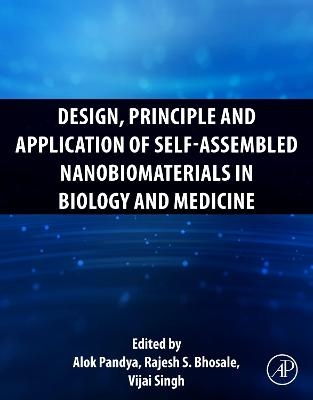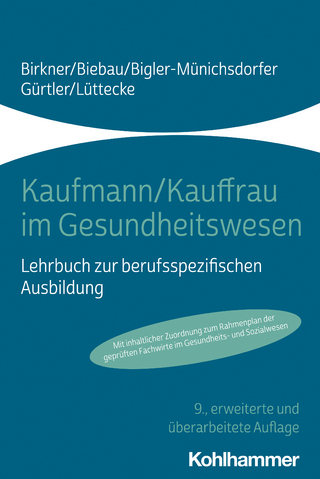
Design, Principle and Application of Self-Assembled Nanobiomaterials in Biology and Medicine
Academic Press Inc (Verlag)
978-0-323-90984-6 (ISBN)
Dr. Alok Pandya is an Interdisciplinary Researcher and Assistant Professor at Department of Engineering and Physical Sciences, Institute of Advanced Research (IAR), Gandhinagar, Gujarat, India. His research work is broadly focused on nanobiotechnology, nanochemistry, and forensic nanotechnology. He has completed his PhD from Gujarat University and awarded with GSA-CHARUSAT Best thesis award for development of various high sensitive nanoassemblies to detect metal ion, non-metal ion, biomolecule and illicit drugs in a forensic context. Later, He joined as Post-Doctoral Research Associate (2013-16) and Young Scientist (2016-17) at Division of biological Sciences, Ahmedabad University, Gujarat, India for development of point of care prognostic kit for cardiac specific biomarker using lateral flow immunoassay. In 2016, he received a first prestigious independent SERB- Young Scientist project to design and development of nanodevice for early detection of multiple cardiac specific biomarker. He has indigenously developed a vertical flow immunoassay-based immunokit for detection CRP and H-FABP. As a reflection, he received multiple translational projects from high repute funding agencies such as SERB-OPDF(Australia), DST, SERB & GSBTM. Currently, his significant research focuses on the development of affordable nanodevice for disease monitoring, agricultural nano-products, and products for societal use. He has published more than 52+ articles in high repute international Journals and published 2 full provisional Indian patent. In addition, he has published 10+ book chapters in the international publishing agency. He has published a 3 books entitled as Introduction of forensic nanotechnology as future armour (Nova Science Publisher USA), Micro/ nanofluidics and lab-on-chip based emerging technologies for biomedical and translational research applications, Volume 186 and volume 187 (Elsevier publications, Netherlands). He is also editor of journal of current nano-toxicology and prevention, Bentham Science Publisher. He has over 9+ Years’ experience of teaching in various subjects such as spectroscopy, nano-chemistry, nanobiotechnology, nano-biosensor, biochemistry, and forensic nanotechnology. He is also IAR placement cell and industrial relations coordinator, member secretary of IAR-student startup and innovation policy, Govt. of Gujarat, member secretary of IAR- Institution innovation council. Dr. Rajesh S. Bhosale is an Associate Professor at School of Sciences, Indrashil University, Rajpur, Mehsana, Gujarat, India. He did his PhD (2009) from University of Geneva (Switzerland) under the supervision of Prof. Stefan Matile. Thereafter, he did first post-doctoral research as SNSF postdoctoral fellow from top institutes of World i.e. MIT-Massachusetts Institute of Technology, Cambridge, USA in the group of Prof. Timothy M. Swager and second post-doctoral research as DFG postdoctoral fellow from FRIAS-Freiburg Institute for Advanced Studies, Germany in the group of Prof. Aurelio Mateo-alonso. Where he was excelled in challenging multistep chemical synthesis, electrochemical, photophysical and self-assembly properties study of small molecules, macromolecules and polymer chromophoric systems. He also served as RMIT research associate in the group of Prof. M. Lakshmi Kantam at CSIR-IICT, Hyderabad and in July 2015 he becomes a CSIR scientist pool officer. His research interests are focused on building AIE active novel molecules. Dr Vijai Singh is a Professor and Dean (Research & Innovation) at School of Sciences, Indrashil University, Rajpur, Mehsana, Gujarat, India. He was an Associate Professor in the Department of Biosciences, School of Sciences, Indrashil University, Rajpur, Mehsana, Gujarat, India. Prior this this, he was an Assistant Professor in the Department of Biological Sciences and Biotechnology at the Institute of Advanced Research, Gandhinagar, India and also an Assistant Professor in the Department of Biotechnology at the Invertis University, Bareilly, India. Prior to that, he was a Postdoctoral Fellow in the Synthetic Biology Group at the Institute of Systems and Synthetic Biology, Paris, France and School of Energy & Chemical Engineering at the Ulsan National Institute of Science and Technology, Ulsan, South Korea. He received his Ph.D. in Biotechnology from the National Bureau of Fish Genetic Resources, Uttar Pradesh Technical University, Lucknow, India with a research focus on the development of molecular and immunoassays for diagnosis of Aeromonas hydrophila. His research interests are focused on building novel biosynthetic pathways for production of medically and industrially important biomolecules. Additionally, his laboratory is working on CRISPR-Cas9 tools for genome editing. He has more than 11 years of research and teaching experience in synthetic biology, metabolic engineering, bioinformatics, microbiology, and industrial microbiology. He has published 100 articles, 70 chapters, 15 books and 3 patents. He serves as an associate editor, editorial board member, and reviewer of several peer-reviewed journals. He is also a member of the Board of Study and Academic Council of Indrashil University and is the Member Secretary of the Institutional Biosafety Committee (IBSC) at the same University.
1. An introduction of self-assembled nanobiomaterials and their applications2. Design and construction of bioinspired supramolecular self-assembled nanostructures3. Design and construction of amino acids, peptides and proteins-based self-assembled nanostructures4. Recent development in chiral self-assembly of porphyrin and protoporphyrin IX molecular architectures5. Design and construction of arlene diimide based self-assembled nanostructures6. Self-assembled functional materials of aggregation-induced emission active molecules7. Design and construction of amphiphilic and bolaamphiphilic material based self-assembled micellar nanostructures 8. Self-assembled living materials and their applications9. 3D bioprinting: overview and recent developments10. Self-assembled peptides and proteins for biomedical applications11. Design and construction of protein and peptide-based self-assembled nanostructures12. Self-assembled nanomaterials for drug delivery13. Carbon nanotubes and graphene nanomaterials for biomedical applications14. DNA/RNA-based self-assemblies for bio-sensing15. Self-assembled nanomaterials for cleansing and bioremediation16. Bio-interfacial DNA self-assemblies for biomedical applications17. DNA nanodevices in nanomedicine and therapeutics
| Erscheinungsdatum | 17.08.2022 |
|---|---|
| Zusatzinfo | 90 illustrations (50 in full color); Illustrations |
| Verlagsort | Oxford |
| Sprache | englisch |
| Maße | 216 x 276 mm |
| Gewicht | 860 g |
| Themenwelt | Studium ► Querschnittsbereiche ► Prävention / Gesundheitsförderung |
| Technik ► Umwelttechnik / Biotechnologie | |
| ISBN-10 | 0-323-90984-1 / 0323909841 |
| ISBN-13 | 978-0-323-90984-6 / 9780323909846 |
| Zustand | Neuware |
| Haben Sie eine Frage zum Produkt? |
aus dem Bereich


